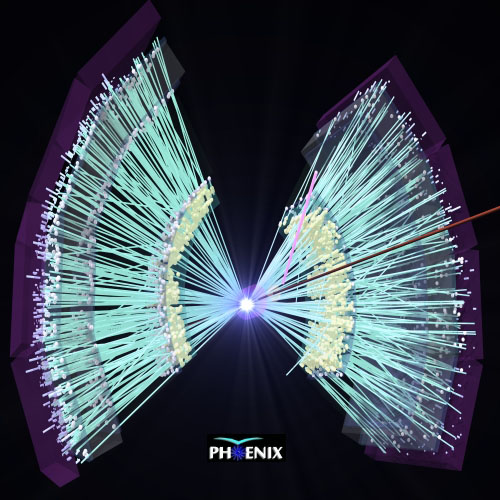 | Thursday, September 15, 2005 |
|
Thursday, September 15 2:30 p.m. Theoretical Physics Seminar - Curia II Speaker: D. Renner, University of Arizona Title: Generalized Parton Distributions from Lattice QCD 3:30 p.m. Director's Coffee Break - 2nd Flr X-Over Note: There will be no Accelerator Physics and Technology Seminar today
Friday, September 16 |
|
Extended Forecast |
Secon Level 3 |
|
Thursday, September 15 - Santa Fe Black Bean - Sloppy Joe - Stuffed Peppers - Sauteed Liver & Onions - Baked Ham & Swiss on a Ciabatta Roll - California Pizza - Crispy Fried Chicken Ranch Salad The Wilson Hall Cafe accepts Visa, Master Card, Discover and American Express at Cash Register #1. |
|
Thursday, September 15 Dinner - Chicken Sun Dried Tomato Rolls - Coconut Shrimp Curry - Lemon Grass Rice - Ginger Souffle w/Rhubarb Sauce
Wednesday, September 21
Chez Leon Menu |
| Fermilab Today is online at: http://www.fnal.gov/today/ Send comments and suggestions to today@fnal.gov Fermilab Today archive Hurricane Relief Page Fermilab Today PDF Version Fermilab Result of the Week archive Fermilab Safety Tip of the Week archive Linear Collider News archive Fermilab Today classifieds Subscribe/Unsubscribe to |
| Fermilab Completes 2005 Staff Reduction |
|
|
|
In March of this year, then-Fermilab Director Mike Witherell announced the necessity of reducing lab staff by 90 positions and introduced a voluntary separation program. The tight budget situation at the laboratory had made the staff reduction plan unavoidable. Seventy-seven employees signed up for voluntary separation and left the lab in May. This week, lab management announced the layoff of 13 employees to achieve the required level of 90 people.
—Kurt Riesselmann |
PHENIX Experiment Uses Grid to Transfer 270 Terabytes of Data to Japan
Going into the polarized proton-proton run, PHENIX faced the challenge that the RCF would be busy reconstructing and analyzing gold-gold and copper-copper data recorded in 2004 and 2005. The enormous polarized proton-proton data set was transferred to Japan to make use of the substantial computing resources at CCJ, which is comparable to the PHENIX portion of the RCF.
The PHENIX data acquisition can sustain a peak data rate of up to 600 megabytes per second, and runs at a typical rate of 250 megabytes per second while beam is stored in RHIC. The data were buffered at the experimental site before being transferred and archived in the RCF tape library. A 35 terabyte disk-storage system (about 60 hours at typical data rates) allowed PHENIX to archive and transfer data at a lower steady rate, taking advantage of various breaks in the flood of data. A transfer rate of 60 megabytes per second sustained steadily around the clock was able to keep up with the incoming data stream.
|
|
September 12 - 14 - During this 48 hour period Operations established one store that combined with an existing store provided the experiments with approximately 45 hours and 22 minutes of luminosity - ComEd glitch causes loss of stash
Read the Current Accelerator Update
|
|
From The Inquirer, September 13, 2005: CERN Itanium system powers large Hadron collider A LARGE Hadron Collider that has a circumference of 27 kilometres and to start operations in 2007 is being designed and tested using an Itanium 2 cluster, Intel said. The chip cluster is being used to run simulations of the heat flow around underground particle detectors. CERN has told Intel that the system can export data at a rate of 600MB per second for 10 days to its sister labs around the world.
|
| Searching for the missing link of quark and lepton symmetry |
||
|
||
|
One of the remaining mysteries of partricle physics is an intriquing
symmetry between quarks (the consituents of protons and neutrons) and
leptons (the most common example is the electron). In nature, quarks and
leptons come in three seemingly matched sets. This intriguing symmetry
could be explained by a new fundamental force, mediated through the
exchange of a melded missing link, aptly called a leptoquark particle.
Experimental limits and symmetry arguments lead to the conclusion that if
leptoquarks exist, they come in three types, each interacting with one
of the pairs.
All three versions of leptoquarks might be produced in proton-antiproton collisions at the Tevatron. The DZero collaboration has recently studied the pair production of leptoquarks that decay into a muon ( a heavy cousin of the electron) and a quark. Such events remain at large: no tracks of leptoquark decay into "normal matter" have been observed. The absence of evidence can be recast as a limit on the mass of the leptoquarks. If leptoquarks are light they are easily produced at the Tevatron; if they are heavy, they are harder to catch. The lower mass limits, derived for leptoquarks that decay 100 percent of the time to muons and quarks (technically called second generation leptoquarks) is 251 GeV, if we combine data from the current and and past Tevatron runs. The lower mass limits, derived for leptoquarks that decay 100 percent of the time to muons and quarks is 251 GeV, if we combine data from the current and and past Tevatron runs. (Technically leptoquarks that decay to muons are called second generation leptoquarks.) The figure above shows the DZero exclusion limits if the decay to muons and quarks occurs 40 to 100 percent of the time.
|
||
| Result of the Week Archive |
|
Note the Change in Date for World Year of Physics Classroom Presentations Brown Bag Orientation has been rescheduled for September 19, from 12:00-1:00 pm, Curia II.
World Year of Physics Symposium for Students and Teachers
Fermilab Happy Hour, organized by the GSA. Everyone is invited!
Building Manager Notice
Fermilab Arts Series
|




